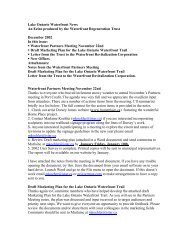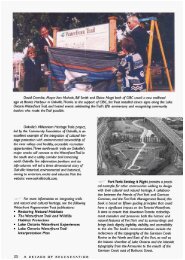Signage Guidelines - Waterfront Trail
Signage Guidelines - Waterfront Trail
Signage Guidelines - Waterfront Trail
- No tags were found...
You also want an ePaper? Increase the reach of your titles
YUMPU automatically turns print PDFs into web optimized ePapers that Google loves.
Design Features of the <strong>Trail</strong>head Signs<strong>Trail</strong>head signs feature a number of components to communicatethe provincial scope of the <strong>Trail</strong> and to encourage inter-municipaltravel. Table 3.4 provides an overview of these components.Table 3.4: Design Features of the <strong>Trail</strong>head Signs• Provincial keymap listing waterfront communities• Depict a regional section of <strong>Trail</strong>• Provide a mileage chart between destinations• Show distance from current location to Niagara andQuébec• Indicate trail surface• Show landmarks• Mark off distances• Show location of facilities (parking) and hazards• Indicate the nearest 401 exit• Prominently display website address where moreinformation is available• Identify trail and bike route connections• Identify Trans Canada <strong>Trail</strong> routeLocation for SignsDetails are provided for the location of large signboards at primaryand secondary trailheads, however, these standards could also beapplied to signs at municipal boundaries and interpretive featuresalong the <strong>Trail</strong>. <strong>Trail</strong>head signs should be provided in the followinggeneral locations (refer to Figure 3.49 and 3.50).• <strong>Trail</strong>head signs should be located adjacent to major parkingfacilities. Where other trails connect parking areas to themain <strong>Waterfront</strong> <strong>Trail</strong> the trailhead sign should be providedadjacent to the main <strong>Trail</strong> rather than the parking lot.<strong>Trail</strong>head signs should be located, if at all possible, withinclear view of the vehicular approach to the parking lot or amajor vehicular route as illustrated. The trailhead sign shouldattract the attention of the passing public and announce theentrance to the <strong>Waterfront</strong> <strong>Trail</strong>. It should not, however,compete with or replace park entry signs.• The trailhead sign should be a minimum of two metresfrom the edge of the travel surface of the <strong>Trail</strong> to providea safe space for viewing. A paved surface is recommendedimmediately adjacent to the sign in heavily used areas.Benches and bicycle lock-ups should also be provided,particularly at large busy parking lots and in areas wherethere are attractions other than the <strong>Waterfront</strong> <strong>Trail</strong>. Placethe trailhead sign to take advantage of existing night lightingwhere possible.• Primary trailhead signs are appropriate for major parkingarea locations.• <strong>Trail</strong>head signs should be located at major pedestrian accesspoints to the <strong>Waterfront</strong> <strong>Trail</strong> in recreational open spaceand at urban points of attraction preferably adjacent tovehicular roadways for additional public exposure. Highpedestrian traffic areas should include benches and otheramenities such as bicycle lock-ups, telephones, washroomsand drinking water.• <strong>Trail</strong>head signs may be placed at the transition fromone municipality to another, announcing the change ofjurisdiction and providing a map of the portion of the<strong>Waterfront</strong> <strong>Trail</strong> which lies in the municipality ahead. Ideallythese transitional trailhead signs should be located at or nearaccess points to the <strong>Trail</strong> and preferably one with parkingnearby.(continued from previous page)Our next milestones will involvecreating stunning entrances tothe Pickering <strong>Waterfront</strong> <strong>Trail</strong>at the mouth of the RougeRiver (Toronto boundary).Currently the connectionbetween Durham and Torontois understated and stairs makeit challenging to navigate formany people. The new gatewayswill be universally accessible andannounce for trail users thatthey are about to experiencePickering’s waterfront.” 11 Doris Chee - Coordinator, Landscape& Parks DevelopmentMunicipal Property & EngineeringDivision, City of Pickering<strong>Waterfront</strong> <strong>Trail</strong> | Design, <strong>Signage</strong> and Maintenance <strong>Guidelines</strong> Update | Section 2 - <strong>Signage</strong> <strong>Guidelines</strong>2-31






